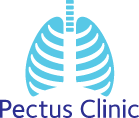Bracing
Bracing for Pectus Carinatum
Bracing for pectus carinatum is well established in many countries to the point that the American Pediatric Surgical Association recommends it as first line therapy for the compliant pectus carinatum deformity. However, in other countries including the UK expertise in bracing for pectus carinatum remains patchy, with little information or knowledge around its use.
For other types of pectus deformity particularly excavatum the role of bracing appears less obvious and the evidence remains patchy and inconsistent. Bracing or strapping may have some role in helping with rib flaring specifically but its role remains unproven.
We run a very popular bracing clinic throughout the year. It is the largest clinic in the UK and has successfully treated 100’s of patients with a custom made pigeon chest brace. After an initial consultation we will assess the most appropriate treatment method for your pectus deformity. Whether it be invasive or non-invasive, we ensure your treatment will be of the highest quality, tailored to your individual needs. For the majority of cases, following measurements including 3D scanning and our unique outpatient procedure to correct the deformity, a custom made brace is fitted and bracing program commenced, that will be all that's needed to restore the ribcage back to a more normal shape.
A bracing system is considered the first line of treatment for pectus carinatum or pigeon chest and is the preferred method to reshape the chest wall.
Please click on the buttons below to see and read about patients verified experiences (in their own words) and testimonials (which generally include before and after treatment photos). The pectus clinic is very grateful to all the patients who provided feedback.
As doctors we are ethically obliged only to offer you a brace if it is likely to be successful, age and 'musculoskeletal maturity' are two important factors. The bracing clinic offers a unique aspect to your treatment, that of 'mobilization or manipulation', a form of physical therapy that concentrates on the source of the pectus deformity, the flexible costal cartilages to gently correct the deformity. This technique significant improves on the success rates as well as reducing the length needed to wear the brace when compared to other brace reports.
Following the manipulation, a sleek, lightweight brace is fitted applying pressure to the ribcage holding the breastbone in a normal position and over time allowing the ribcage to 'remodel' for a permanent result. The brace is customized to fit each person for maximum comfort and effectiveness. The brace allows unrestricted arm motion and can even be worn during physical activities (except for some contact sports). For the brace to be effective it must be worn virtually everyday for the first 8 weeks along with daily exercises which will be instructed by your consultant. At around 12 weeks the brace and results are checked and re-adjusted according to the patients needs. At 3 months following our individually prescribed program the brace will be worn less and less frequently for typically a further 3 to 6 months depending on severity. A second rib brace is not needed with this bracing program though a soft flexible rib strap may be.
The pectus bracing program lasts around 8 to 12 months, and we recommend that we see you 2 to 3 times after the first consultation to assess progress, adjust the brace fitting and give advice around reducing the amount of time the brace is worn. Patients, depending on their needs as part of our follow-up pectus program will also go through a customized exercise and physical therapy assessment, evaluation and training program.
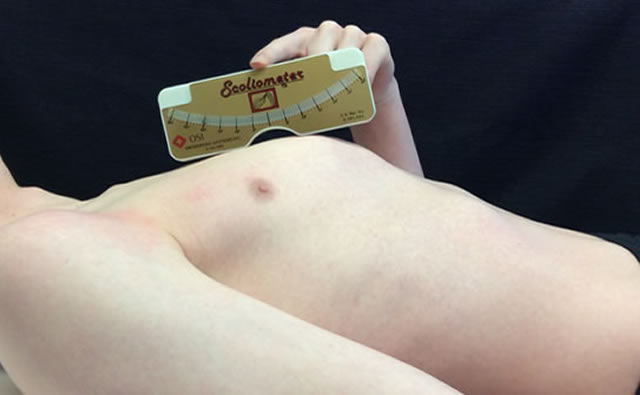
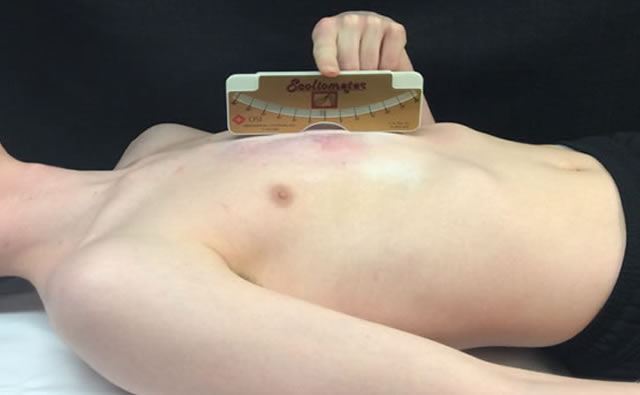
Measurements taken before (top) and 6 weeks after starting a brace program (bottom) for a boy with severe asymmetric pectus carinatum
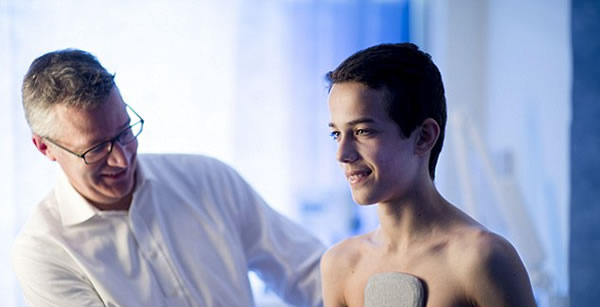
The low-profile light weight brace used by the Pectus Clinic is custom built using the latest 3D technology following measurements and then re-checked following bracing to
guarantee an ideal fit. At further follow-ups, the brace will be altered as the pectus carinatum remodels to give the best long-term results
Summary of external compressive bracing program*
- Assessment includes pressure measurement of chest wall flexibility
- Individual custom brace made to fit all types of pigeon chest
- Fitting of brace includes ‘manipulation’ (correction) of pigeon chest and custom brace fitting with adjustments
- For first 8 weeks brace is worn permanently (off for washing only)
- After 8 weeks brace is removed for 1-2 hours each day
- After 12 weeks brace is removed increasingly each day
- By 24 weeks the brace is worn 12 hours a day only
- By week 32 the brace is worn for maintenance only
- The brace program finishes after week 40
*The typical bracing schedule for a teenager, the schedule does vary based on age, severity & flexibility of the chest deformity
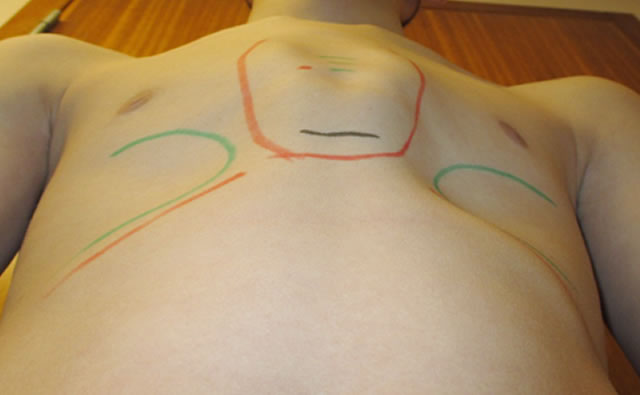
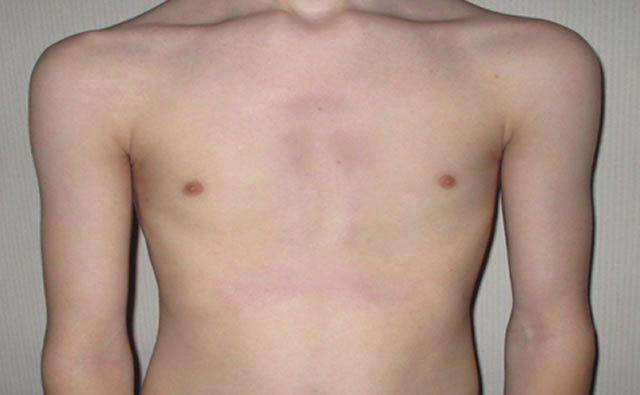
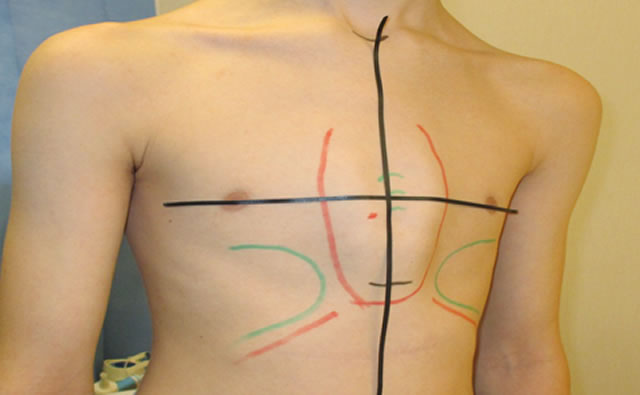

Photos (to the left) showing the initial pectus deformity taken as part of the assessment prior to bracing. The red marks protrusion of the chest wall and the green where the chest is dipping in. To the right, photos 6 months after starting the brace program when the brace is being worn at nighttime only.
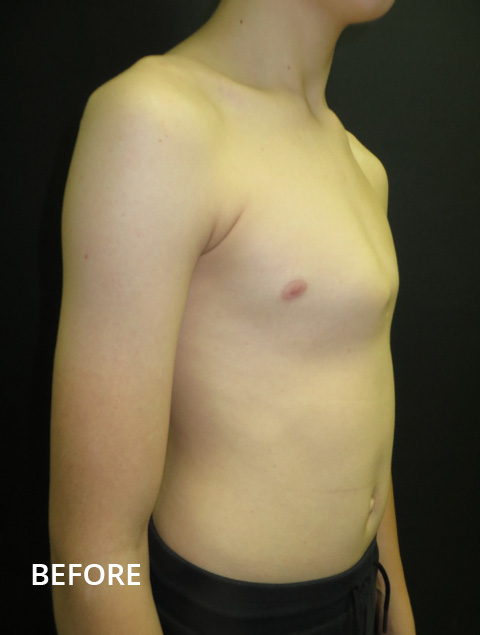
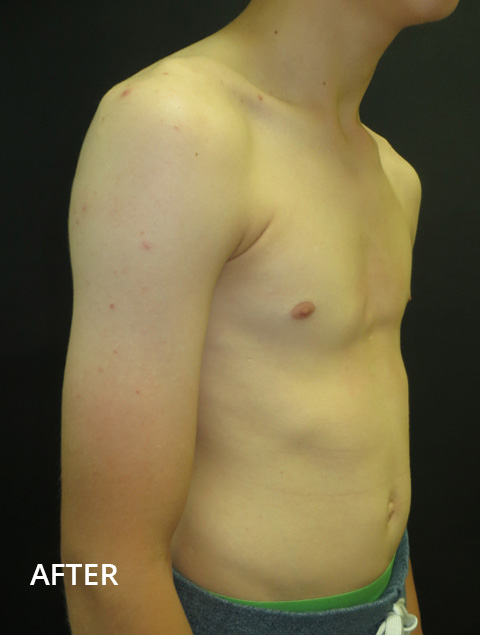
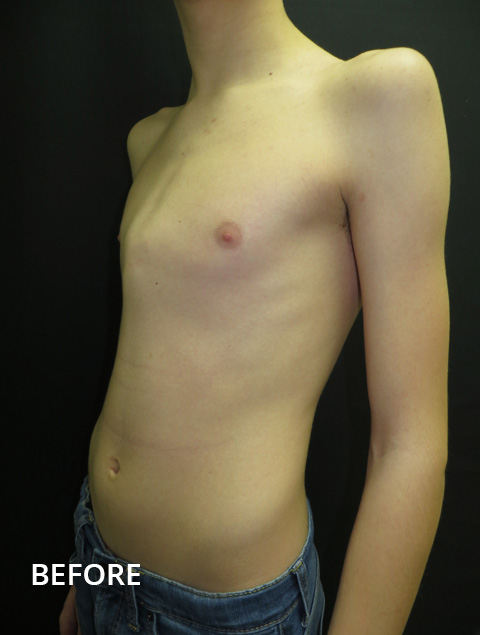
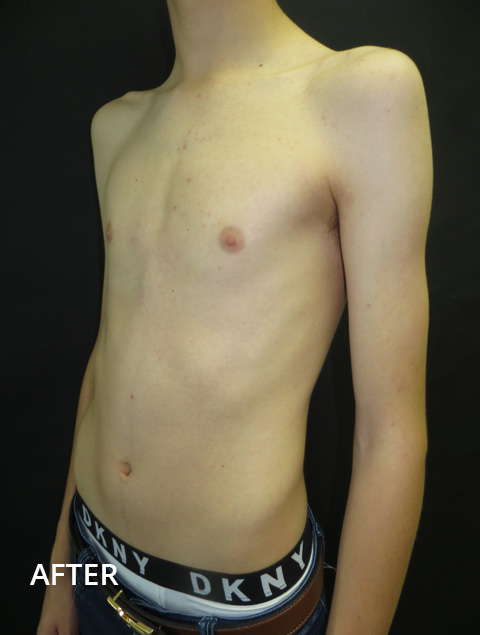
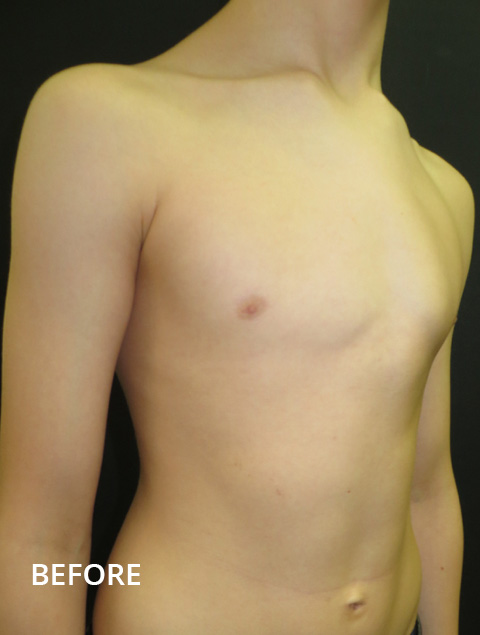
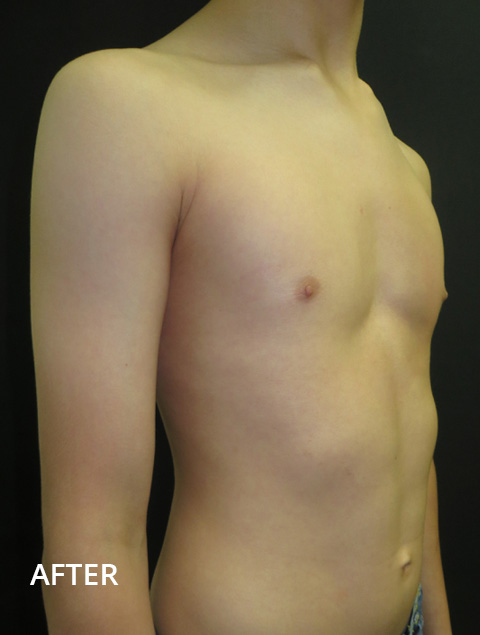
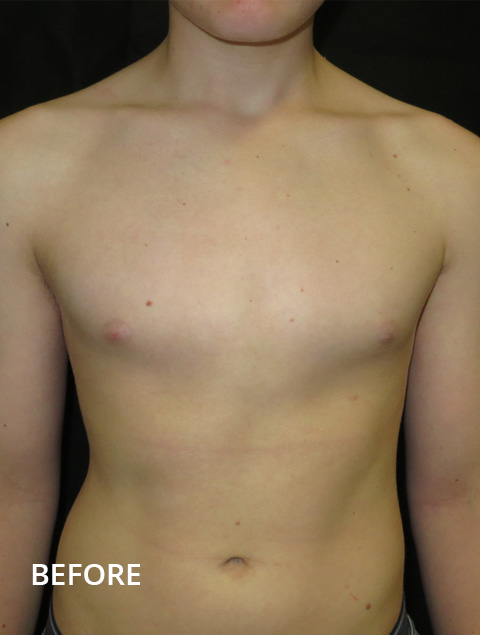
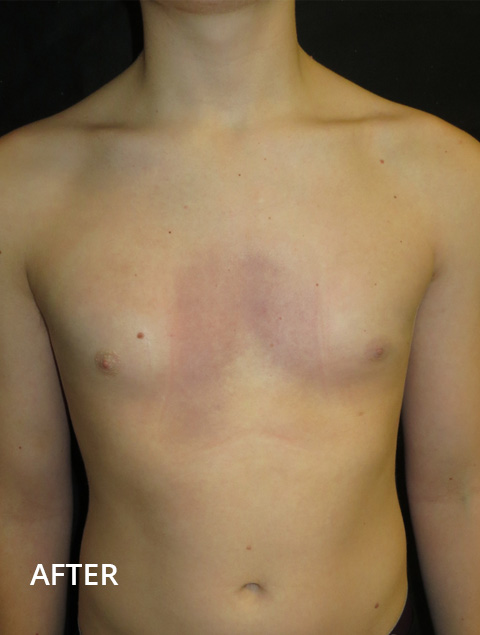
Before and after images shown using the slider (drag central cursor left or right to view) of four patients with pectus carinatum before and 6 months after bracing treatment.
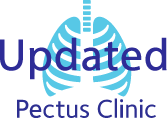
Frequently Asked Questions about external compressive bracing for treatment of pectus carinatum (Pigeon Chest)
Bracing is a non-surgical technique that relies on sustained pushing on the front of the chest over the protrusion of the pigeon chest to permanently correct or significantly improve the appearance of the chest. As such it is like ‘teeth braces’ relying on some ‘flexibility’ (that is why age is important) as well as time for chest wall remodelling and correction to take place.
External bracing often described as dynamic compression bracing is a well-established treatment for pigeon chest with the American Paediatric Surgical Association (APSA) in 2012 recommending it as the first line therapy for the compliant pectus Carinatum (or pigeon chest) deformity based on its scientific assessment of the medical literature.
Yes. The Pectus Clinic is run by doctors who practice evidence-based practice and are ethically obliged to offer treatments that are likely to be successful. In that regard, data is collected and outcomes of patients who have been treated with external compression bracing by the Pectus Clinic have been published in peer reviewed journals and presented in national and international meetings.
Most bracing techniques rely on progressive tightening of an external compressive brace over time with or without the use of pressure measurements to assess suitability and progress. Known as dynamic compression bracing, there are many scientific publications supporting its use. However, the length the brace needs to be worn can vary considerably from reports of a few months to a few years, as well as some concerns about how successful the brace is worn during this time, what doctors call ‘compliance’. Though rarely reported, the type, fitting and comfort of the brace will certainty affect the success of bracing to treat pigeon chest.
As well as offering dynamic compression bracing, the Pectus Clinic (where suitable) offers an additional treatment (what doctors call an adjunct) involving ‘manipulation’ of the pigeon chest prior to custom fitting of the brace to the chest to a more corrected position before the brace is worn. It is based on several well described physiotherapy techniques collectively called ‘soft tissue release’. It involves the soft cartilage joints between the breastbone and ribs (the origin of the pectus deformity) being gently pushed back into a more normal position prior to the brace fitting. Having started the chest correction, the brace then holds the chest in its corrected or nearly corrected position. Our data suggests it appears to improve on how long the brace needs to be worn and particularly the compliance of the brace wearing. It is not essential, but certainty helps get the best result.
The technique is aimed at treating most patients, male or female with this type of deformity. However, there are three important considerations: Age, what is called ‘musculoskeletal maturity’ (essentially both reflect chest wall flexibility) and the type of pectus carinatum.
The brace corrects the chest deformity by applying sustained pressure to the chest wall and specifically the soft cartilage joints between the breastbone and ribs (the origin of the pectus deformity) holding them in position and over time allowing re-modelling of the chest for a permanent correction.
Age is important and is a useful guide to how much flexibility the chest has. As we get older these cartilaginous joints become increasingly stiff and bone-like making brace correction more difficult. People ‘age’ at different rates and so even though they may be in their 20’s they still may have some flexibility in these joints and of course vice versa. This is what musculoskeletal maturity means. Finally, most types of pectus carinatum involve the lower sternum or breast bone, but rarely an upper or high pectus carinatum can develop. This type of deformity is much more difficult to treat with an external compressive bracing technique.
Mr Hunt, the Pectus Clinic Medical Director and a very experienced consultant Thoracic (chest) surgeon clinically assesses all patients prior to recommending external compressive bracing treatment. This is done using various clinical tools including a 3D scanner and the use of a pressure gauge to assess amount of pressure required to correct (push) on chest to flatten to a natural shape and position.
Yes, age matters. Bracing is most effective in young patients with flexible chest walls and offers a permanent correction. The average age of patients having bracing at the Pectus Clinic is 14 years old. Currently our age range of patients who have successfully worn the brace and achieved results that they rated as very good or Excellent was from 8 years of age to 30 years of age. The type of bracing schedule we recommend can be adjusted to age, and though taking longer a brace may still be appropriate in older age groups.
One reason is that you have been miss-diagnosed, and that you don’t have a pectus Carinatum. Expert assessment by Mr Hunt prior to starting a bracing program ensures the correct diagnosis and the correct treatment offered.
Maybe. Rib flare where the bottom of the rib cage sticks out is common in both pigeon chest and with other types of pectus deformity. It is often quite prominent, particularly on the left and can sometimes actually become more obvious when treating pigeon chest with a brace especially in young patients. In this situation, time and exercises are often all that’s needed to improve its appearance. However, sometimes we recommend using a custom fitted ‘rib strap’ designed by the Pectus Clinic to help support the rib cage during the bracing. Occasionally, if the rib flare is severe we may recommend a specially designed rib flare brace.
Ideally yes but it is not essential. Sometimes apparent ‘pigeon-chest’ may be caused by another issue or be associated with other problems. In that regard seeing your GP for an initial assessment and appropriate tests before seeing the Pectus Clinic may be helpful. Remember the Pectus Clinic is run by doctors and it is regarded as ‘good practice’ that the Pectus Clinic receives a referral from your GP and it will assist in booking the appointment at Spire St. Anthony’s Hospital. Following the consultation, a clinic letter (unless otherwise requested not to) will be sent to your GP and/or referring doctor.
Yes, generally. The Pectus Clinic will request photographs of your chest wall deformity and some basic medical information about your issue. If following this ‘screen’, the Pectus Clinic’s Medical director, Mr Hunt, will make arrangements to see you. The consultation will clarify the diagnosis of pigeon-chest, the need for further investigation, concerns around suitability for the bracing treatment or any other issue related to your pectus deformity.
The initial consultation with Mr Hunt to assess your pectus deformity normally takes around 45 minutes and include clinical assessment, photographs, measurements including a pressure measurement to assess suitability of bracing and a 3D scan as well as discussion about what the treatment involves.
No, generally not. Occasionally though if there is doubt about the pectus diagnosis or the best treatment to recommend, a radiological investigation to assess further will be requested but this is not usual. Very occasionally, a further genetic assessment may be requested if there are concerns of an underlying congenital or genetic disorder such as Marfan syndrome.
Please contact the Pectus Clinic Administrator for a prompt reply and details including information required and if suitable an opportunity for an initial consultation with Mr Hunt. The Pectus Clinic runs throughout the year. Once measurements are taken, a custom brace is ordered. It takes around 3-4 weeks from measurements to brace fitting.
Nothing specific but would suggest wearing loose fitting clothes and coming with a friend or relative. You will be fine to travel by public transport or drive home, but you may feel sore in the chest after the outpatient’s appointment. The brace fitting appointment last around 45mins.
No, but the success of bracing can be significantly improved by this uniquely-applied physiotherapy technique of first reducing, mobilising and correcting the deformity then using the custom-made brace to ‘hold’ the chest in its new corrected position while it ‘remodels’ over time and so the correction is permanent. There is good evidence it reduces the length of permanent brace wear and most importantly significantly improves ‘the compliance’ (wearing the brace) so that you complete the schedule. If you do not wish to have the manipulation or for some reason are not suitable for this a custom pectus brace can still be created for you and expertly fitted. However, the correction may take longer, so the brace would need to be worn longer with more adjustments required.
If appropriate following assessment this will be offered. The manipulation or mobilisation performed to flatten or reduce the deformity is an important and unique part of the technique we use to treat the pigeon chest. Mr Hunt working with the specialised pectus service representative have developed this technique and are the only pectus treatment group in the world using this method. A type of soft tissue release or manipulation used commonly by physiotherapists but uniquely applied to the chest wall cartilages, it is performed as an outpatient procedure. The actual mobilisation and reduction of the cartilage between the breastbone and ribs takes around 15-20 minutes and is done as gently as possible. It is essentially a very deep massage of the chest with focused pushing on the flexible cartilages back into the correct or near correct position. It is uncomfortable and occasionally a little painful, but we use a local anaesthetic cream and warming the chest prior to the mobilisation to help reduce the discomfort. Once the chest is flattened the brace is fitted and holds the chest in its new position. Do we have evidence of its effectiveness? Yes, the Pectus Clinic has published its outcomes and demonstrated that the manipulation technique improves the outcome of external bracing and reduces the length the brace has to be worn.
Usually following the bracing for a few days, we would recommend taking simple painkillers like ibuprofen regularly, the pain quickly wears off and no painkiller is usually needed after the first 5 days.
The pectus clinic works with Crispin orthotics, a leading UK based orthotics company building its own custom-made 3D printed pectus chest wall brace. The brace design is based on the Pectus Clinic’s years of experience of treating thousands of patients with pectus deformity and uses a precise 3D scan taken of the patient’s chest, followed by using the latest 3D printing technology to make a well fitted comfortable brace. The brace is made of a high-grade polymer and though very strong remains light and easy to wear particularly to sleep in.
The brace is made of a high-grade Nylon based polymer covered with medical foam. It’s designed to be light, low profile and worn next to the skin. It comes with a set of fronts, back and side washable covers.
After the manipulation (if used), custom fitting and bracing, we then arrange to see you the next day (and rarely the day after that) for a further assessment. This is to check the brace and its fit, to make any adjustments and to check that the skin is not irritated. At that point, we will go through the personalised bracing program. The time to be seen will be confirmed after the first appointment and for those travelling to the Pectus Clinic from a distance you may need to decide to stay overnight in London.
Yes, but the Pectus Clinic can provide a list of local hotels and give details around travel times.
Generally, no but certainty the following day or two after bracing you may feel a little sore and may wish to take a day off.
Advice will be given and is determined by type and severity of the deformity, but in general the brace is worn continuously for the first 3-4 days. On the 4th day, we recommend a 15-20-minute break for a shower. After that the brace is worn for 8 weeks in most cases with a 15-20-minute break each day for washing. In most cases, after 8 weeks a 1-2-hour break from wearing the brace per day is recommended. A detailed written wearing schedule will be provided with the bracing program.
The Pectus Clinic provides detailed written information about wearing the brace, its maintenance and lots of useful tips as well as a detailed written customised wearing schedule which will be explained to you.
The wearing schedule is based on extensive analysis of the data collected by the Pectus Clinic and knowledge of other bracing programs around the world. There are essentially 2 types of wearing schedule:
1. Intensive schedule: typically aimed at younger patients with flexible pectus deformities. The program lasts usually for around 9-10 months and should be completed in a year.
2. Progressive schedule: aimed at older patients with less flexible chest walls. The program lasts usually around 12-18 months.
Occasionally a bespoke schedule will be suggested depending on the patient’s age, severity, flexibility and personal circumstances.
After the first 4 days of continuous wear, there are three phases:
1. Wearing Phase: the first part, it is near continuous 8 weeks of wear with short daily breaks for washing only. This is followed by 4 weeks of removing the brace for 1-2 hours per day only.
2. Weaning Phase: the second part, where the brace is taken off daily more and more over 3-6 months.
3. Maintenance Phase: the third phase, where the brace is worn intermittently like a ‘retainer’ 2-3 times per week for a further 3-6 months. It tends to be the least predictable and is very related to age the patient starts the program and on-going growth spurts with younger patients having a longer maintenance period than older patients.
Like the intensive wearing schedule, ideally the brace should be worn for the first 3-4 days continuously. It follows similar phases as the intensive schedule but is slower and relies on ‘progressively’ tightening the brace of time:
1. Wearing Phase: The brace is worn as much as possible from the first week, typically 12-16 hours per day and certainty more than 12 hours a day to achieve an improvement in the pectus carinatum deformity. The brace is tightened slowly over time. How this is done will be shown to you and the brace may need to be tightened two, three or more times during the course of the program. The schedule offers a guide for when to tighten but does not need to be followed strictly. The wearing phases usually lasts around 6 months.
2. Weaning Phase: the second part, once the desired result is achieved (usually around 6 months into the bracing program), the brace is taken off daily more and more over the next 3-6 months. Guidance will be given.
3. Maintenance Phase: the third phase, where the brace is worn intermittently like a ‘retainer’ for a further 3-6 months.
A written wearing schedule is provided with guidance provided with most patients following the schedule as prescribed. For the intensive schedule, the average length of bracing is around 9-10 months to a year. However, there is some variability around the time needed to correct the pectus and sometimes it may be required to be worn longer depending on the severity and response to treatment. You will be guided through this. For the progressive schedule, the bracing program typically lasts 12-18 months.
Where the brace touches the chest and the back, the skin can be affected and care particularly in the first few weeks should be taken to avoid a skin problem such as a pressure sore. Advice will be given about what to watch for and how to look after your skin whilst wearing the brace.
Skin problems can occur due to excessive pressure on the skin, irritation caused by rubbing or due to a pre-existing skin problem such as acne. In the first days of wearing the brace, care should be taken to monitor for excessive pressure and if concerned contact the Pectus Clinic. Advice includes using simple aqueous based emollients daily to maintain healthy skin. If the skin is irritated a barrier cream such as Sudocrem© is helpful. Occasionally, if the skin is starting to breakdown or ulcerate, the brace should be loosened, and a supportive dressing pad worn along with application of antiseptic barrier cream. Rarely, the brace program may need to be interrupted if the skin does not heal.
The brace has a low profile but as each brace is custom fit its shape and size are dependent on the type of deformity you have. In general, it will be noticeable if only a T-shirt is worn but not if a baggy T-shirt is worn or if you are wearing more layers such as a baggy jumper or coat. But remember, your pectus deformity may have been as equally or more noticeable.
We recommend that you are seen 2 or occasionally 3 times after the first consultation to assess progress, adjust the brace fitting and give advice around reducing the amount of time the brace is worn.
Ideally you should be seen 12 weeks after bracing for a review (or within 24 weeks for the progressive schedule). After this review, often (but not always) it is recommended that brace wearing is reduced by several hours each day (the weaning period). A further Pectus Clinic review will be offered typically at 6-7 months and finally only if needed at around 12 months following the start of the bracing program. Further appointments after that are usually not required.
Yes, please contact us if any worries, concerns or if you wish to check something. Often the best way is to simply email the pectus clinic. An email to us will be provided. We can arrange a Virtual consultation if preferable/required.
Yes, occasionally if the pectus carinatum corrects quickly, particularly in the first 4-8 weeks, the chest can actually overcorrect slightly and appear to dip in. This is more common in patients with very flexible chest walls and in those patients who ‘over-tighten’ the brace. It requires no specific treatment, but simple adjustments to the brace tightness and often starting to take the brace off daily earlier than the usual intense 12-week wear. If concerned, simply contact the Pectus Clinic for on-going brace advice.
Pectus deformity is often associated with other musculoskeletal problems, sometimes called 'pectus posture'. All patients as part of our follow-up pectus program will be shown specific exercises that will help other posture-related problems such as stooped shoulders.
Not usually necessary but The Pectus Clinic works with the department of Physiotherapy at Spire St. Anthony’s and with Bodymechanics physiotherapy group and in conjunction with them have developed some specific exercise programs around musculoskeletal issues often seen in patients with pigeon chest. If required, during your assessment a recommendation for additional physiotherapy will be made. This can then be booked to follow the bracing follow-up.
Yes. The brace can be worn during sports and exercise though there are some restrictions around contact sports such as rugby or martial arts as there is a risk during heavy contact (to the opposition). In general, we recommend not wearing the brace during such contact sports, but the decision whether you can play or not will be for your coach or trainer.
But remember, the brace is only worn permanently in most for the first 12 weeks with opportunities after 8 weeks to remove the brace for short periods (1-2 hours) each day, usually after this time you can tailor periods when not wearing the brace around any sport activities.
Swimming is probably best avoided, as continual immersion in water will affect the 'wear and tear' of the brace. Remember, once the 12 weeks is completed (or even after 8 weeks for short periods) most will be able to start wearing the brace less often and with period's off when they are able to play any sport, they like including swimming.
For the keen swimmer, we offer an additional brace designed to be used specifically in water. It is a ‘stripped’ down version of the standard brace and is very light, waterproof and can be immersed in water for long periods. However, we do not recommend this brace as a ‘replacement’ for the standard brace. Ask for more information about it when you enquire about the pectus bracing program as it will need to be ordered.
The overall cost of the pectus-bracing program is designed to be affordable and certainty when compared to the cost of teeth bracing is comparable. For costs and payment methods please contact the Pectus Clinic administrator.
The Pectus Clinic was set up specifically to offer the best impartial advice for your pectus deformity. Because its run by doctors and other health care professionals who truly understand chest wall problems and pectus deformities specifically, we can provide all the information you need and help you decide what options you have.
If external compressive bracing is not the treatment for you, alternative treatments offered by the Pectus Clinic include a ‘hybrid’ procedure involving minimal access keyhole surgery with or without subsequent bracing, as well as more traditional surgical approaches. These treatments will be discussed with you following assessment.
Please click on the buttons below to see and read about patients verified experiences (in their own words) and testimonials (which generally include before and after treatment photos). The pectus clinic is very grateful to all the patients who provided feedback.
Bracing for Rib Flare
Bracing for rib flare is far less established than for compliant pectus carinatum deformities and external bracing, though the principles are the same. The lower rib cage (the costal margin) is made of costal cartilage and like pigeon chest is often very flexible particularly in young patients.
As with bracing for pectus carinatum, rib flare bracing needs a flexible chest. A rib strap strap can be used but if too severe a rib flare brace may be recommended. Following measurements including a scan a rib flare brace is custom made. The rib flare brace is fitted at a separate clinic appointment. It needs to be worn typically for at least 8 hours per day and is usually worn for 9-12 months. It’s Important it’s used together with specific targeted exercises.
Please click on the buttons below to see and read about patients verified experiences (in their own words) and testimonials (which generally include before and after treatment photos). The pectus clinic is very grateful to all the patients who provided feedback.
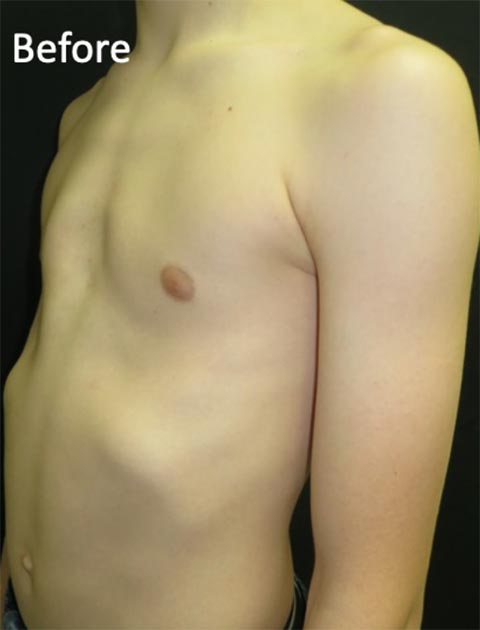
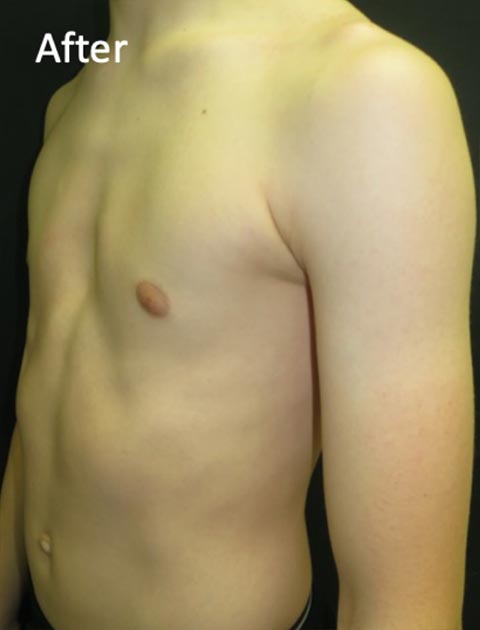
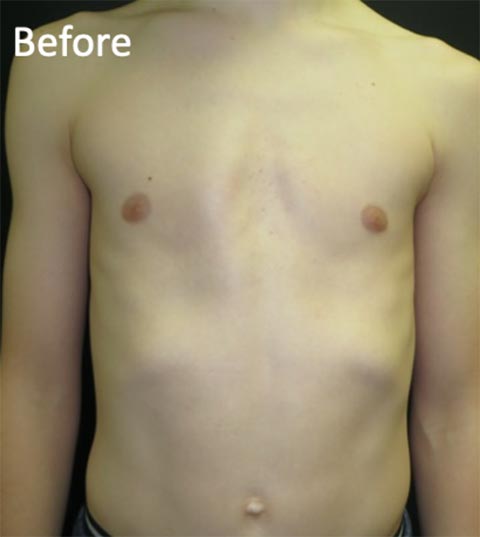
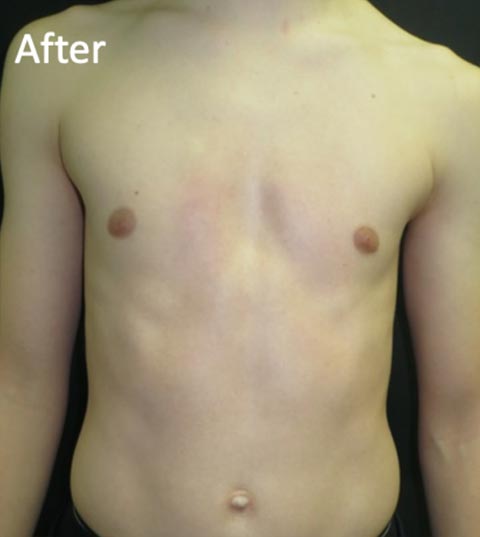
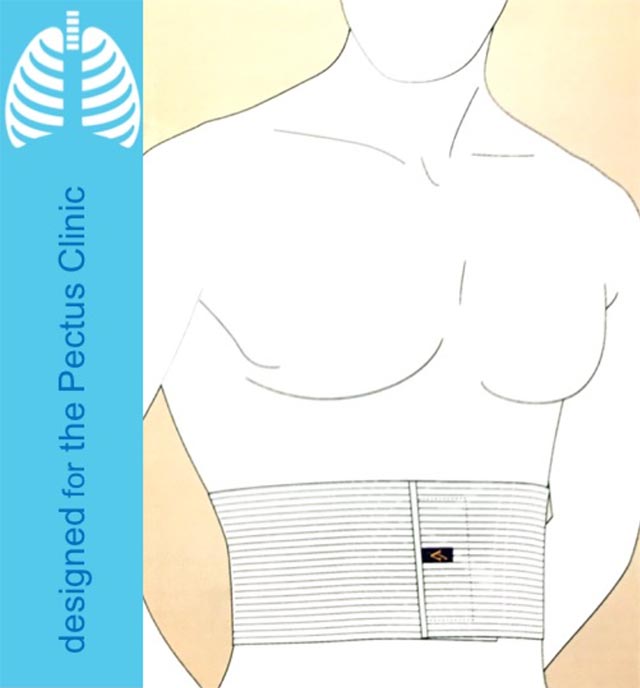
When indicated, a custom-made rib flare strap combined with the pectus brace helps correct rib flare combined with targeted exercises to strengthen the ‘core abdominal muscles’.
Patient with a mild pectus carinatum and rib flare before (left) and after (right) treatment with an external brace, a rib flare strap (above) and targeted physical exercises.


Patient with Pectus Excavatum and rib flare before (left) and after (right) using a rib flare brace worn for around 8 months combined with target core abdominal exercises (shown to right).
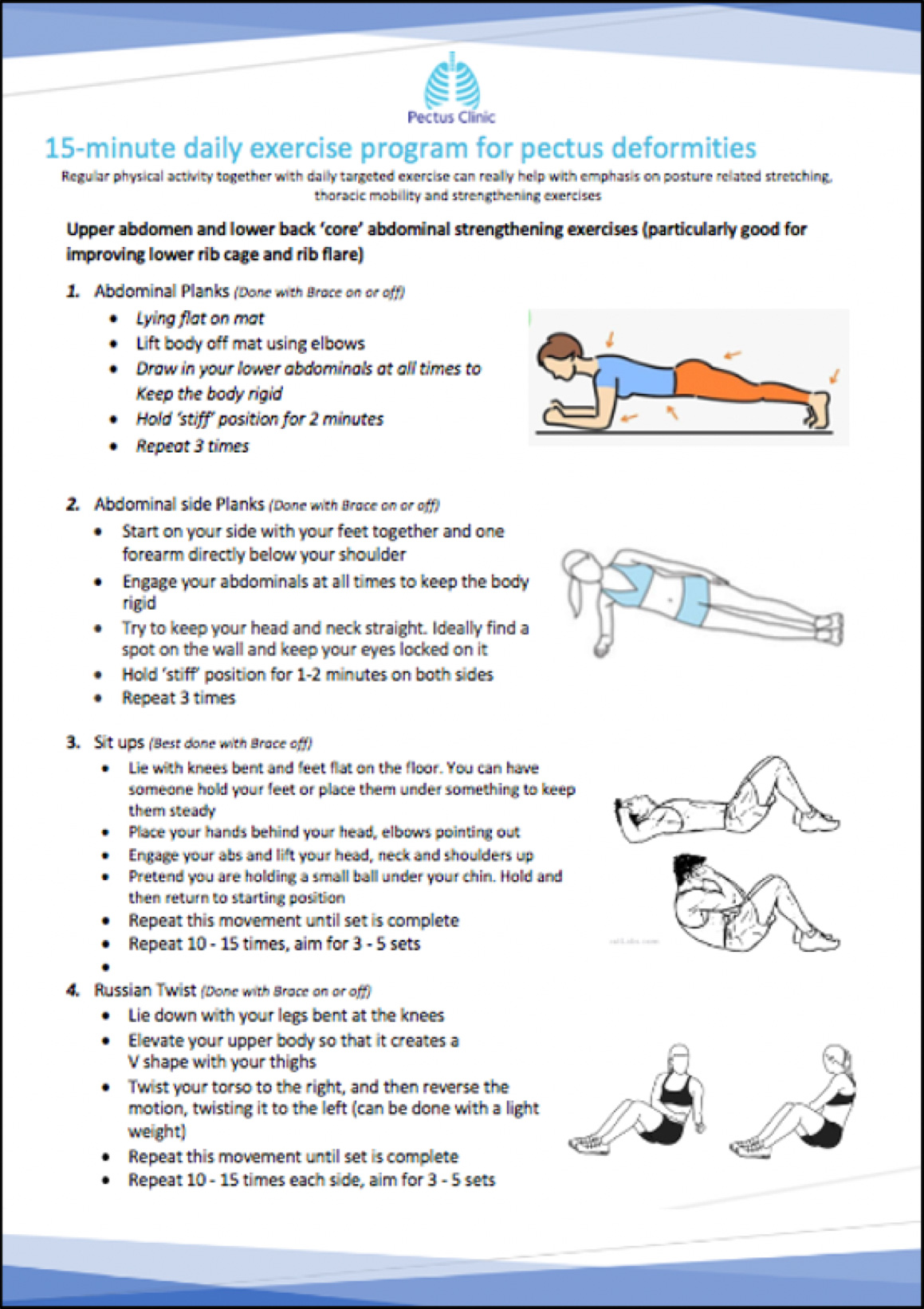

Frequently Asked Questions regarding Rib flare
Rib flare affects the lower ribs and the lower edge of the ribcage (the costal arch or margin). The lower ribs can be flared where the ribs and the costal margin either on one (usually the left) or both sides are pulled upwards and stick out.
In both pectus excavatum and carinatum as well as mixed deformities the lower ribs can be flared. Often Rib flaring can often appear to be the most significant deformity associated with otherwise a minor pectus excavatum or carinatum deformity. Rib flaring can also appear to be isolated without any other obvious abnormality.
Yes. In older patients with Chronic Obstructive Lung Disease (smoker’s lung) the chest can become ‘barrel-shaped’ and the lower rib cage can stick out as an apparent ‘rib-flare’. It is acquired and is due to the overall barrel shaped chest and is not related to pectus deformity. The lower rib cage shape can also change with age, is different in men and women as well as body shape particularly central obesity (truncal or abdominal obesity affecting the midriff also known as belly fat).
Treatment for rib flare is quite limited and depends at what age you are seen, how severe and what underlying pectus problem you have as well as how much flexibility you have in your rib cage. The treatment options include external compressive bracing and surgery.
Maybe. Rib flare where the bottom of the rib cage sticks out is common in both pigeon chest and with other types of pectus deformity including pectus excavatum. It is often quite prominent and sometimes causes more concern that the pectus deformity or can even be the only issue. In patients with flexibility in the rib cage (which tends to be younger patients), a rib flare brace may improve the cosmetic appearance. However, it’s important to understand medically there is little data supporting the role of a rib brace in terms of long-term permanent outcomes.
Occasionally, when treating pigeon chest with an external brace the associated rib flare may get slightly worse. It appears to be an effect of pushing on the breastbone which can cause the lower rib cage to ‘rise’ up. It is more likely to occur in younger patients with very flexible chest walls and in patients who respond very quickly to the external brace. In most cases, the rib flare can be managed either with simple exercises, and as the pigeon chest brace is worn less often through the course of the wearing schedule, it will improve with time. In addition, a simple custom rib strap has been developed specifically to be worn with the brace if rib flaring is a problem before or during the bracing treatment. It acts to counteract the effect of the brace.
The Pectus Clinic has developed with a major-medical garment manufacturer (Design Veronique®) a rib flare strap to be used in treating rib flare alone or in combination with external bracing or following surgery. As the rib flare needs to be worn around the upper abdomen it is much more comfortable than a semi-rigid rib brace and therefore is much more likely to be worn for long periods. However, it is unlikely to correct severe rib flare and a more formal rib brace made be required, though often once the desired improvement is achieved switching to a rib strap may be possible.
Yes, rib flare is seen in both types of pectus deformity. In patients been treated with Vacuum Bell Therapy (VBT) who have significant rib flare a rib flare strap is typically also used. In more severe rib flare, as with pectus carinatum a formal custom-made rib flare brace may be recommended.
Yes, the treatment of rib flare with bracing includes exercises. Specific exercise regimes to target and develop core muscle groups particularly the oblique muscles may offer the best chance of improving rib flaring combined with a rib flare strap or brace but requires dedication and hard work.
Limited, but surgery may occasionally be considered either as part of surgery to treat the underlying pectus problems or rarely to deal with the rib flare in isolation. The surgery typically involves making cuts in the cartilage and removing ‘wedges’ to reduce the deformity. This may require insertion of a metal support to reduce the risk of creating instability in the lower rib cage, one potential risk of surgery as well as holding the rib cage in its new shape. Surgical options can be discussed at the time of your Pectus Clinic consultation.
Please click on the buttons below to see and read about patients verified experiences (in their own words) and testimonials (which generally include before and after treatment photos). The pectus clinic is very grateful to all the patients who provided feedback.
Gallery
We take numerous measurements and photos before, during and after bracing treatment as many of the problems we see centre around appearance. With the patient's permission we are happy to share our outcomes.
Results
It is important that we can show evidence that the bracing treatment we offer and the results that we achieve are proven. We actively collect data to allow us to study, research and publish are outcomes.
